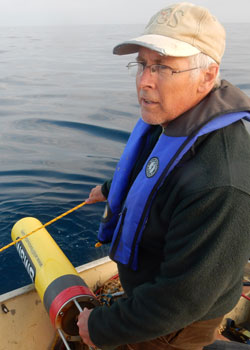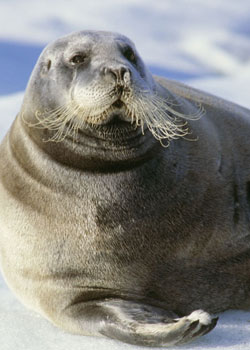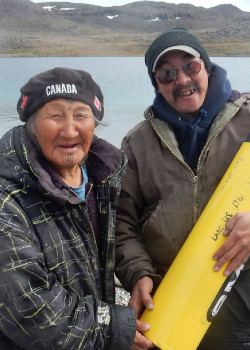The challenge
Arctic wildlife have evolved to live in a cold northern climate – timing their lives to coincide precisely with snow and ice melt, freeze-up, and other natural rhythms. But despite the cold and many months of darkness, the Arctic region boasts highly productive ecosystems both on land and in the Arctic Ocean. WCS Canada is focused in particular on the marine environment in the Arctic, with its many different fish, whales, seals and other wildlife, because this rich underwater and shoreline environment is facing major changes, including a loss of sea ice and increased ship traffic and development pressures.
The Arctic has long been one of the quietest environments on Earth thanks to a thick covering of ice, but this is changing as climate change causes ice to recede or thin out. With growing ship traffic -- both cruise ships taking passengers on a new adventure and cargo ships taking a shortcut between Asia and Europe – noise and traffic is increasing and creating a more challenging environment for marine mammals.
In fact, climate change – which is happening at twice the rate as in the rest of the world here -- is dramatically altering the Arctic environment and impacting all wildlife. On land, warmer temperatures lengthen the growing season, allowing shrubs and trees to move further north, melting permafrost and causing lakes to drain, and softening and eroding the normally ice-armored coastlines, reducing critical bird and fish habitat. Finally, the timing of snow and ice melt is earlier and more extensive, allowing wildlife normally found further south, such as grizzly bear, fox, and a variety of fish, to move further north and compete with their Arctic counterparts.
Adding to the problem is the growing pressure for industrial development, in particular oil-and-gas development both onshore and off. High-value mineral resources could also lead to large-scale mining in new areas as well as new roads and year-round shipping.
.jpg?ver=2019-02-26-183057-713)



What we are doing and why
We are working with our international colleagues to address conservation challenges across three nations in Arctic Beringia – the Russian Federation, United States, and Canada – while working with local indigenous governments and communities in both Alaska and Canada. Our goal is to change land-use and conservation planning approaches so that they take a more holistic approach to protecting key areas and reducing development impacts instead of relying on piecemeal project approvals that can lead to steadily growing cumulative impacts.
WCS Canada is particularly involved in working with local Inuvialuit communities to assess potential shipping noise impacts on marine life in the Bering, Chukchi and Beaufort Seas as more ships begin to travel through the previously ice-choked Northwest Passage. We are using our findings to put forward specific harm-reduction practices -- such as slowing ships or avoiding migration corridors during key periods -- to both the international Arctic Council and the Canadian government.
Our strategies
We have deployed underwater sound monitoring equipment in key areas used by whales and seals in the Beaufort Sea to track the presence of marine mammals and to quantify ship noise and soundscape changes over a number of years. Our publications on these issues include modelling ship noise footprints, assessing effective noise mitigation strategies for ships (such as slower speeds), detecting the timing of marine mammals and fish activity in the region, and quantifying background noise levels from different natural and human sources.
We are also monitoring ecological changes and ecosystem health in the Arctic marine environment through methods like measuring the diets of local ice seals. To do this, we work closely with our local Inuvialuit partners on a community- based monitoring approach, one of the ways in which we show our deep respect for their traditional knowledge.
Finally, there is also a strong international aspect to our work that acknowledges that our conservation efforts often need to cross national boundaries. For example, we prepared a key chapter on Arctic mammals for an assessment of status and trends in the Arctic’s biodiversity for the international Arctic Council, that informed negotiations at the Arctic Council. We also led the northern Yukon (Herschel Island and Ivvavik National Park) component of the International Polar Year project called Arctic WOLVES (Arctic Wildlife Observations Linking Vulnerable EcoSystems). This project involved a globe-circling network of Arctic wildlife observatories for a study of the impact of climate change on tundra food webs.
We have also recently completed a global assessment of noise in the Arctic marine environment for the Arctic Council’s PAME (Protection of the Arctic Marine Environment) working group. This is being used to find international solutions to address increasing noise in the Arctic. You can hear firsthand what a ship passing through the Arctic, ice creaking or a beluga whale chirping sounds like on the ArcticNoise.ca website.
Latest news
- Dr. Steve Insley contributes to a paper with its key messages summarized in this BEPSII Policy Brief on Effective Arctic climate change mitigation and adaptation strategies require consideration of biogeochemical and ecological impacts of sea-ice decline.
- Eavesdropping on whales - we sit down with Dr. William Halliday, one of our resident Arctic marine mammal experts, in this audio interview to learn how the Arctic soundscape is changing and why, and what that means for our underwater giants.
- WCS Canada was asked to develop a State of Knowledge report on underwater noise in the Arctic for the Arctic Council’s Protection of the Arctic Marine Environment (PAME) working group. We discuss this work in a blog for the Revelator.
- Taking it slow in the arctic can help marine mammals. A recent paper co-authored by WCS Canada scientists looks at the benefits of slower ship speeds for noise reduction and to lower collision risk. The work is summarized in a piece for Mongabay.
- Protecting whales in an ice-free Arctic: As Arctic sea ice vanishes, new measures are needed to protect marine wildlife from increased ship traffic. We discuss what can be done in a piece for Canadian Geographic.
- The sounds of the north: exploring the underwater soundscape of the western Canadian Arctic from Medium.
- What Is Making All That Arctic Noise? We go beneath the surface in a piece for National Geographic
- Listening for giants. A Mongabay piece describing our Arctic marine noise research.
- What’s that sound? Ship noise in the Arctic: How animals use sound and the how introduced noise can interfere with these functions in our Muddy Boots blog.